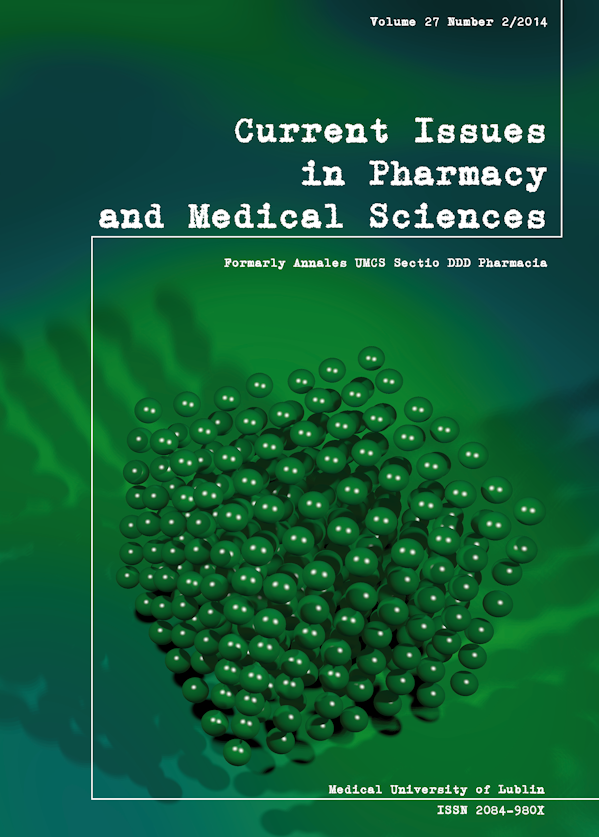Effect of N-(m-bromoanilinomethyl)-p-isopropoxyphenylsuccinimide on the anticonvulsant action of four classical antiepileptic drugs in the mouse maximal electroshock-induced seizure model
DOI:
https://doi.org/10.2478/cipms-2014-0017Keywords:
antiepileptic drugs, maximal electroshock-induced seizures, N-(m-bromoanilino-methyl)-p-isopropoxyphenylsuccinimideAbstract
The purpose of this study was to determine the effects of N-(m-bromoanilinomethyl)- p-isopropoxyphenylsuccinimide (BAM-IPPS - a new succinimide derivative) on the protective action of four classical antiepileptic drugs (AEDs: carbamazepine [CBZ], phenobarbital [PB], phenytoin [PHT] and valproate [VPA]) in the mouse maximal electroshock (MES)-induced tonic seizure model. Tonic hind limb extension (seizure activity) was evoked in adult male albino Swiss mice by a current (sine-wave, 25 mA, 500 V, 50 Hz, 0.2 s stimulus duration) delivered via ear-clip electrodes. BAM-IPPS administered (i.p.) at a dose of 150 mg/kg significantly elevated the threshold for electroconvulsions in mice (P<0.05). Lower doses of BAM-IPPS (50 and 100 mg/kg) had no significant impact on the threshold for electroconvulsions in mice. Moreover, BAM-IPPS (100 mg/kg) did not significantly affect the anticonvulsant potency of CBZ, PB, PHT and VPA in the mouse MES model. BAM-IPPS elevated the threshold for electroconvulsions in mice in a dosedependent manner. However, BAM-IPPS (100 mg/kg) did not affect the anticonvulsant action of various classical AEDs in the mouse MES model, making the combinations of BAM-IPPS with CBZ, PB, PHT and VPA neutral, from a preclinical point of view.
References
1. Kamiński K., Obniska J.: Synthesis and anticonvulsant properties of new 1-(2-pyridinyl)- 3-substituted pyrrolidine-2,5-dione derivatives. Acta Pol. Pharm., 65, 457, 2008.
2. Lange J. et al.: Synthesis and properties of new cyclic derivatives of succinic acid with anticonvulsant activity. Pharmazie, 32, 82, 1977.
3. Litchfield J.T., Wilcoxon F.: A simplified method of evaluating dose-effect experiments. J. Pharmacol. Exp. Ther., 96, 99, 1949.
4. Löscher W., Fassbender C.P., Nolting B.: The role of technical, biological and pharmacological factors in the laboratory evaluation of anticonvulsant drugs. II. Maximal electroshock seizure models. Epilepsy Res., 8, 79, 1991.
5. Łuszczki J.J. et al.: Effects of three N-(carboxyanilinomethyl) derivatives of p-isopropoxyphenylsuccinimide on the anticonvulsant action of carbamazepine, phenobarbital, phenytoin and valproate in the mouse maximal electroshock-induced seizure model. Eur. J. Pharmacol., 648, 74, 2010.
6. Łuszczki J.J. et al.: Influence of N-(p-acetylphenyl)-p-isopropoxyphenylsuccinimide on the protective action of classical antiepileptic drugs against maximal electroshock-induced seizures in mice. Curr. Issues Pharm. Med. Sci., 26, 76, 2013.
7. Łuszczki J.J. et al.: Influence of N-hydroxymethyl-p-isopropoxyphenylsuccinimide on the anticonvulsant action of different classical antiepileptic drugs in the mouse maximal electroshock-induced seizure model. Epilepsy Res., 100, 27, 2012.
8. Łuszczki J.J. et al.: No effect of 3-(N-p-isopropoxyphenylsuccinimidomethylamino)-cinnamic acid on anticonvulsant action of different classical antiepileptic drugs in mouse maximal electroshock-induced seizure model. J. Pre-Clin. Clin. Res., 6, 20, 2012.
9. Łuszczki J.J., Kocharov S.L., Czuczwar S.J.: Effect of p-isopropoxy-phenylsuccinimide monohydrate on the anticonvulsant action of carbamazepine, phenobarbital, phenytoin and valproate in the mouse maximal electroshock-induced seizure model. Pharmacol. Rep., 62, 194, 2010.
10. Łuszczki J.J., Kocharov S.L., Czuczwar S.J.: N-(anilinomethyl)-p-isopropoxyphenyl-succinimide potentiates the anticonvulsant action of phenobarbital and valproate in the mouse maximal electroshock-induced seizure model. Neurosci. Res., 64, 267, 2009.
11. Rogawski M.A., Bazil C.W.: New molecular targets for antiepileptic drugs: alpha(2)delta, SV2A, and K(v)7/KCNQ/M potassium channels. Curr. Neurol. Neurosci. Rep., 8, 345, 2008.
12. Stables J.P., Kupferberg H.J. (1997). The NIH Anticonvulsant Drug Development (ADD) Program: preclinical anticonvulsant screening project. In: Molecular and cellular targets for anti-epileptic drugs. Avanzini G., Regesta G., Tanganelli P., Avoli M. (editors). London: John Libbey; p. 191.
13. White H.S. et al. (2002). Discovery and preclinical development of antiepileptic drugs. In: Antiepileptic drugs. 5th ed. Levy R.H., Mattson R.H., Meldrum B.S., Perucca E. (editors). Philadelphia: Lippincott Williams & Wilkins; p. 36.
14. Zejc A. et al.: Synthesis and anticonvulsant properties of some arylsuccinate methylpyridylimides. Pol. J. Pharmacol. Pharm., 42, 69, 1990.
15. Żółkowska D. et al.: Effects of N-(morpholinomethyl)-p-isopropoxy-phenylsuccinimide on the protective action of different classical antiepileptic drugs against maximal electroshock-induced tonic seizures in mice. Pharmacol. Rep., 65, 389, 2013.
Downloads
Published
Issue
Section
License
Copyright (c) 2014 Authors

This work is licensed under a Creative Commons Attribution-NonCommercial-NoDerivatives 3.0 Unported License.


